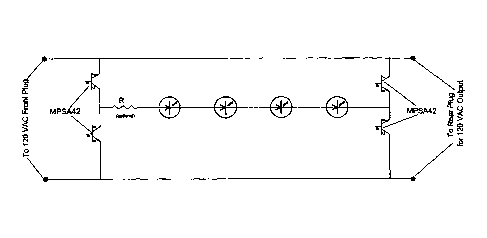Some of the information on this Web page has been provided by external sources. The Government of Canada is not responsible for the accuracy, reliability or currency of the information supplied by external sources. Users wishing to rely upon this information should consult directly with the source of the information. Content provided by external sources is not subject to official languages, privacy and accessibility requirements.
Any discrepancies in the text and image of the Claims and Abstract are due to differing posting times. Text of the Claims and Abstract are posted:
| (12) Patent Application: | (11) CA 2840699 |
|---|---|
| (54) English Title: | FULL WAVE LOW FLICKER LED LIGHT STRING |
| (54) French Title: | GUIRLANDE LUMINEUSE A DEL A FAIBLE SCINTILLATION ET DOUBLE ALTERNANCE |
| Status: | Deemed Abandoned and Beyond the Period of Reinstatement - Pending Response to Notice of Disregarded Communication |
| (51) International Patent Classification (IPC): |
|
|---|---|
| (72) Inventors : |
|
| (73) Owners : |
|
| (71) Applicants : |
|
| (74) Agent: | SMART & BIGGAR LP |
| (74) Associate agent: | |
| (45) Issued: | |
| (22) Filed Date: | 2014-01-24 |
| (41) Open to Public Inspection: | 2015-02-08 |
| Availability of licence: | N/A |
| Dedicated to the Public: | N/A |
| (25) Language of filing: | English |
| Patent Cooperation Treaty (PCT): | No |
|---|
| (30) Application Priority Data: | |||||||||
|---|---|---|---|---|---|---|---|---|---|
|
A split bridge circuit for rectifying the alternating current house supply
into direct current (D.C.), using bi-polar transistor as rectifying
devices. Using
the collector and emitter terminals of bi-polar
transistors results in a high forward voltage drop across the
transistors (particularly as compared to the voltage drop across diode
rectifiers in the prior art circuits), which reduces ripple significantly
and lessens, or even eliminates, the need for a series limiting resistor
in the circuit.
Note: Claims are shown in the official language in which they were submitted.
Note: Descriptions are shown in the official language in which they were submitted.

2024-08-01:As part of the Next Generation Patents (NGP) transition, the Canadian Patents Database (CPD) now contains a more detailed Event History, which replicates the Event Log of our new back-office solution.
Please note that "Inactive:" events refers to events no longer in use in our new back-office solution.
For a clearer understanding of the status of the application/patent presented on this page, the site Disclaimer , as well as the definitions for Patent , Event History , Maintenance Fee and Payment History should be consulted.
| Description | Date |
|---|---|
| Inactive: IPC expired | 2020-01-01 |
| Inactive: IPC assigned | 2019-10-15 |
| Inactive: IPC assigned | 2019-10-15 |
| Application Not Reinstated by Deadline | 2019-01-24 |
| Time Limit for Reversal Expired | 2019-01-24 |
| Deemed Abandoned - Failure to Respond to Maintenance Fee Notice | 2018-01-24 |
| Change of Address or Method of Correspondence Request Received | 2018-01-12 |
| Inactive: IPC expired | 2016-01-01 |
| Inactive: IPC removed | 2015-12-31 |
| Inactive: Cover page published | 2015-02-16 |
| Application Published (Open to Public Inspection) | 2015-02-08 |
| Inactive: IPC expired | 2015-01-01 |
| Inactive: IPC removed | 2014-12-31 |
| Inactive: Filing certificate - No RFE (bilingual) | 2014-03-24 |
| Inactive: IPC assigned | 2014-03-06 |
| Inactive: IPC assigned | 2014-03-06 |
| Inactive: IPC assigned | 2014-02-13 |
| Inactive: First IPC assigned | 2014-02-13 |
| Inactive: Filing certificate - No RFE (bilingual) | 2014-02-05 |
| Application Received - Regular National | 2014-02-04 |
| Small Entity Declaration Determined Compliant | 2014-01-24 |
| Inactive: Pre-classification | 2014-01-24 |
| Abandonment Date | Reason | Reinstatement Date |
|---|---|---|
| 2018-01-24 |
The last payment was received on 2016-08-10
Note : If the full payment has not been received on or before the date indicated, a further fee may be required which may be one of the following
Patent fees are adjusted on the 1st of January every year. The amounts above are the current amounts if received by December 31 of the current year.
Please refer to the CIPO
Patent Fees
web page to see all current fee amounts.
| Fee Type | Anniversary Year | Due Date | Paid Date |
|---|---|---|---|
| Application fee - small | 2014-01-24 | ||
| MF (application, 2nd anniv.) - small | 02 | 2016-01-25 | 2015-08-04 |
| MF (application, 3rd anniv.) - small | 03 | 2017-01-24 | 2016-08-10 |
Note: Records showing the ownership history in alphabetical order.
| Current Owners on Record |
|---|
| INC. JLJ |
| Past Owners on Record |
|---|
| JOHN L. JANNING |